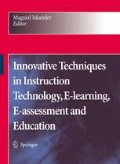Abstract
Due to increasing demand for simulation and modeling, efforts are needed to build up more powerful simulation and modeling methodologies that can help to facilitate learning complex dynamic systems. By learning we mean the acquisition of knowledge, skills and experience for better and faster learning of the various types of complex dynamic systems. System dynamics is one of the successful well formulated methodologies that provides a perfect framework for building highly interactive learning environments where learners involve in reasoning about the relationships between the structure and the dynamics of a complex system. In this paper, we address two recent well known approaches (Black-Box and Glass-Box) that enhance learning capabilities in a typical complex dynamic system and demonstrate the overall learning effectiveness by using their own methodologies. Furthermore, we present a critical comparison of traditional black-box approach and the innovative glass-box approach. In addition, we also present two experiments that are associated with the black-box approach. These experiments will be very helpful for understanding the inadequacy of a black-box approach when compare it to the glass-box approach.
Access this chapter
Tax calculation will be finalised at checkout
Purchases are for personal use only
Preview
Unable to display preview. Download preview PDF.
References
Dean L. Christensen, J. Michael Spector, Alexei V. Sioutine, Dalton Mc Cormack, “Evaluating the impact of system dynamics based learning environments: Preliminary study,” Paper presentation at the international system dynamics society Meeting, University of Bergen, Bergen, Norway, 8 August, 2000.
Marcelo Milrad, J. Michael Spector, Pal I. Davidsen, “Model Facilitated Learning,” accepted for publishing in a volume edited by Som Naidu entitled eLearning: Technology and the development of teaching and learning.
Jay W. Forrester, “Learning through system dynamics as preparation of the 21st century,” Keynote address for system thinking and dynamic modeling conference for K-12 education at Concord Academy Concord, MA, USA, June 27-29, 1994.
Senge P. M, “The Fifth Discipline: the Art and Practice of the Learning Organization,” New York – London – Toronto –Sidney- Auckland 1990.
Salomon G, “Distributed cognitions: Psychological and educational considerations,” New York: Cambridge University Press, 1993.
Scandura J.M, “Theoretical foundations of instruction: Past, present, and future,” Journal of Structural Learning, 12(3), 231-243, 1995.
Sterman J. D, “Learning in and about complex systems: System Dynamics Review,” 10(2/3), 291-300, 1994.
Spector J.M, Davidsen P.I, “Cognitive complexity in system dynamics based learning environments,” Presented at the International System Dynamics Conference, Istanbul, Turkey, 21 August, 1997.
Davidsen P.I, Spector J. M, Milrad. M, “Learning in and about simple systems,” In R. Y. Cavana, J. A. Vennix, E. Rouwette, M. Stevenson-Wright, J. Cavendish (Eds.), Proceedings of the 17th International Conference of the System Dynamics Society and 5th Australian & New Zealand Systems Conference. Wellington, NZ: Webrights, 1999.
Sterman J.D, “People express management flight simulator,” Cambridge, MA: Sloan School of Management. 1998.
Dorner D, “The logic of failure: Why things go wrong and what we can do to make them right,” (R. Kimber & R. Kimber, Trans.). New York: Metropolitan Books. (Original work published in 1989)
Aviv, R., Z. Erlich, G. Ravid, and A. Geva,“Network Analysis of Knowledge Construction in Asynchronous Learning Networks,” Journal of Asynchronous Networks, vol. 7, pp. 1–23, 2003
R. Aviv, Z. Erlich, and G. Ravid, “Reciprocity Analysis of Online Learning Networks”, Journal of Asynchronous Networks,Volume 9, Issue 4 - December 2005
Author information
Authors and Affiliations
Editor information
Editors and Affiliations
Rights and permissions
Copyright information
© 2008 Springer Science+Business Media B.V.
About this paper
Cite this paper
Riasat, A., Rizvi, S.S., Zehara, F., Arain, F. (2008). The Role of System Dynamics in Learning Environments. In: Iskander, M. (eds) Innovative Techniques in Instruction Technology, E-learning, E-assessment, and Education. Springer, Dordrecht. https://doi.org/10.1007/978-1-4020-8739-4_95
Download citation
DOI: https://doi.org/10.1007/978-1-4020-8739-4_95
Publisher Name: Springer, Dordrecht
Print ISBN: 978-1-4020-8738-7
Online ISBN: 978-1-4020-8739-4
eBook Packages: Computer ScienceComputer Science (R0)

